Pantex Blog
College Pre-Hires Visit Pantex
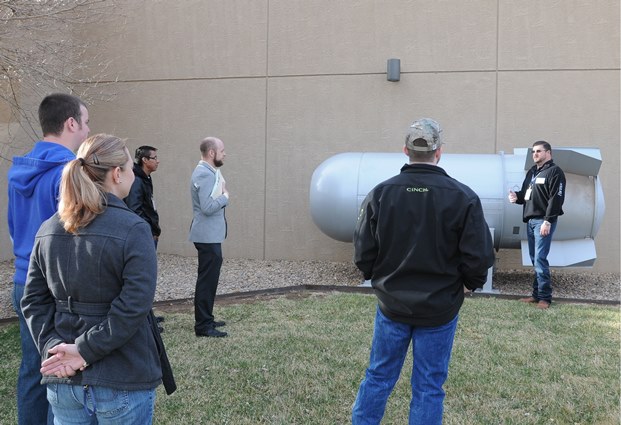
Engineering has always been an in-demand skill at Pantex, and for six years, the Pantex College Pre-hire program has worked well to help meet the need. But the growing demand for employees in other hard-to-fill jobs has meant the program is branching out in a new direction.
Shane Rogers, who has managed the pre-hire program since it started in 2007, just returned from a month-long tour of seven colleges in Texas and New Mexico. In addition to engineers, Rogers was looking for scientists and IT professionals who had important knowledge they could bring to the plant.
“We have had so much success finding and hiring engineers with the pre-hire program that other divisions started to approach us to see if we could help out,” Rogers said. “We’re hopeful that we’ll be just as successful expanding into these new areas.”
This is the first year Rogers looked for computer science (CS) and computer information systems (CIS) majors, in addition to the traditional engineering, math and science majors. The number of high-paying jobs in the IT marketplace makes it extremely difficult to find and recruit people with that skill set.
The pre-hire program reaches out to juniors and seniors who will agree to come to work at Pantex, in exchange for reimbursement of tuition and fees for up to two years. A group of students are interviewed at the schools, then selected candidates are invited to come to Pantex for a second interview and a chance to see some of the work done at the plant. The first semester of the program in 2007, Rogers made offers to six students. This semester, he hopes to make 26 offers.
Recruiters visit a variety of schools proximate to Pantex, including West Texas A&M, Oklahoma State, Texas Tech, University of Texas at El Paso, New Mexico State, New Mexico Institute of Mining and Technology and University of New Mexico. Students from as far away as Tennessee and Maryland have been invited for onsite visits following phone interviews.
“The idea is to essentially create a pipeline for students to come to Pantex from schools in our area,” Rogers said. “It benefits them by helping to defray some of the cost of tuition, and it certainly benefits Pantex by recruiting and retaining talented employees.”
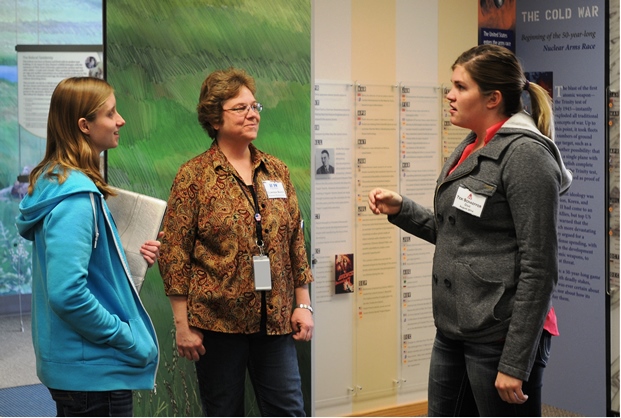
Pantexans Donate Cookware to Charity
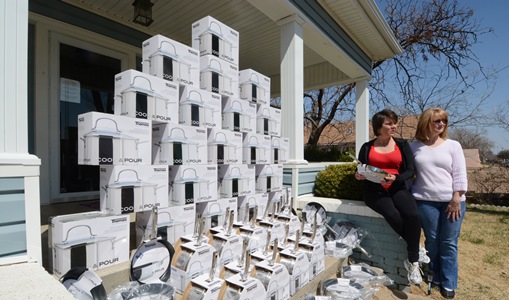
Cooking dinner will be a lot easier for about 20 needy families in Amarillo thanks to the generosity of Pantexans, who used a grocery store promotion to secure more than $6,000 of cookware for a local charity.
More than 70 pots and pans were donated to local charities by Pantexans Scott and Lauri Minton, who had been collecting stickers donated by their coworkers. The stickers represent nearly $100,000 in groceries purchased from United Grocery Stores, an area chain that has been giving stickers redeemable for cookware since October.
“I think this really represents the Pantex spirit. As Pantexans, we are always looking for ways to have a positive impact on our communities,” said Lauri Minton.
Lauri Minton said she and her husband started collecting the stickers when they realized they did not need new pots and pans, but that there were people in Amarillo who did. The Mintons spread the word around the plant, and were quickly overwhelmed with the positive response.
As the promotion entered the final days, word spread through social media, and the pace of giving picked up even more.
The pots and pans – over 21 complete sets – were dropped off at Martha’s Home Friday, an Amarillo shelter that provides a place to live for homeless women with children while guiding them toward a lifestyle of self-sufficiency. Several pots and pans were also donated to the Pantex Christmas Project, which has been providing Christmas gifts to needy families for more than 50 years.
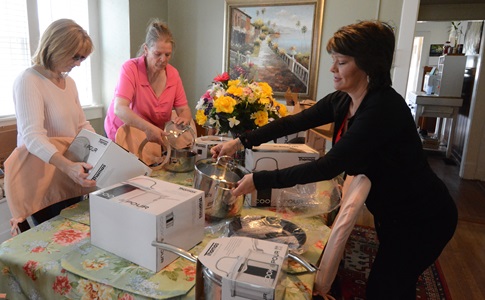
Wild Pantex – One of Three
Article by Jim Ray, Pantex Wildlife Biologist/Scientist
The U.S. Department of Energy/National Nuclear Security Administration and Pantex eagerly await word on the announcement of the winner of the 2014 Presidential Migratory Bird Federal Stewardship Award. Abstracts for Pantex and the two other national finalists are now posted on the U. S. Fish and Wildlife Service’s web page for the Council for the Conservation of Migratory Birds.
Wouldn't it be something if we won - this the most unlikely place to even be listed for that award! The selection is to be made April 15.
Plant Tradition: Lunchtime card game ongoing for 40 years
Though some of the faces have changed, there’s one thing that hasn’t. If it’s lunchtime at Pantex, there’s a game of Spades taking place. What started as a way to pass the time in the cafeteria during lunch is a ritual for Andy Marshall, Dale Moon, Jimmy Myers and Kevin Brown, whose job it is to bring the cards.
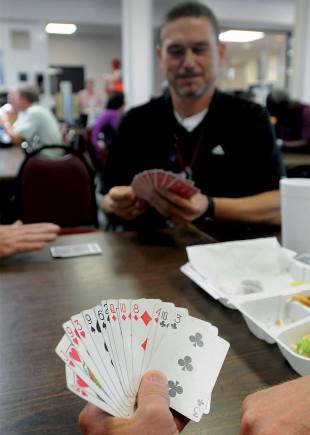 “It’s fun. I see it as a break in the action of the job. Kinda like recess in elementary school,” said Myers, a technical advisor and 33-year Pantex veteran. Eight hands are played each day with scores recorded in a log book. Why Spades? “It’s easy to play and eat at the same time,” said Myers. “Not much strategy involved.”
“It’s fun. I see it as a break in the action of the job. Kinda like recess in elementary school,” said Myers, a technical advisor and 33-year Pantex veteran. Eight hands are played each day with scores recorded in a log book. Why Spades? “It’s easy to play and eat at the same time,” said Myers. “Not much strategy involved.”
Two alternate players, Kenny Steward and Mike Brinson, fill in when needed. On call are Barry Hill, Pablo Reyes, Adam Myers and Ron Wilcox.
“People play until they retire, leave or are unable to play,” explained Myers. “We then usually let the first alternate in the game replace the starter.” At times, players leave Pantex to work elsewhere and then return to the Plant, as is the case for Steward and Brinson. “They are waiting for their chance to be the starting pitcher, rather than a bullpen ace,” said Myers.
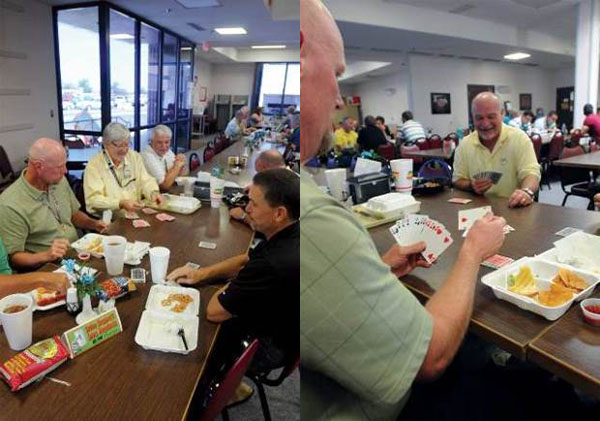
There’s not much Kevin Brown, program manager and 18-year Pantex veteran, doesn’t like about the lunchtime card game. “The camaraderie and competition, with a little trash talking, allows us a break from the hectic day, even though for just a short period of time,” he said. “It can be a stress reliever.”
Special rules keep the 40-year-old game interesting. One is that no matter how far behind you are, you can win in the last hand. But serious business it isn’t. “We usually remember everyone’s most ignorant play and then keep reminding them about it later,” said Myers.
Among Myers’ favorite memories is the time then-General Manager Denny Ruddy approached the group to ask what they were playing. “We all thought, well, I guess this game has come to an end. But, he was truly interested and began making fun of how Steward was playing his hands.”
CoLOSSIS Key to Nondestructive Stockpile Analysis
Pantex Home to World’s Only Computed Tomography Imaging System for Pit Surveillance
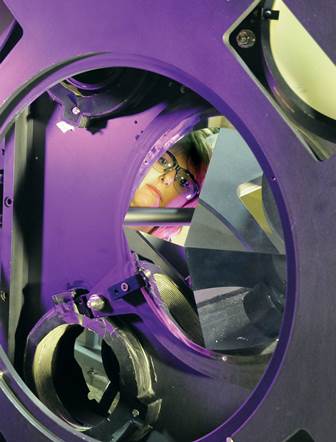
Dana Landrum, Quality Assurance technician, is reflected in the four-sided pyramidal mirror of CoLOSSIS, a computed tomography imaging system unique to Pantex and used to nondestructively determine the integrity of pits.
What does it take to look inside the core of a nuclear weapon? Start with four cryogenically cooled astronomy cameras capable of 8,000 by 8,000-pixel images, one four-sided pyramidal mirror and a burst of photons generated by an X-ray source nearly 100 times more powerful than a medical computed tomography (CAT) scan, and you have the world’s only computed tomography imaging system used to determine integrity of pits – CoLOSSIS.
As many as 1,800 images of each pit are taken over multiple days at Pantex using the Confined Large Optical Scintillator Screen and Imaging System, or CoLOSSIS, to nondestructively determine if they will function as expected. A pit is a component made of plutonium metal and is the heart of a nuclear weapon. The imaging is conducted on surveillance units as designated by the National Laboratories.
Prior to the introduction of CoLOSSIS three years ago, film was used for analysis of pits, which offers only a two-dimensional perspective. But confidence in the nation’s nuclear stockpile required more efficient technology.
The 32,000-pound, lead-shielded CoLOSSIS is operated by highly trained quality assurance technicians whose background stems from the medical or industrial non-destructive evaluation fields.
It takes an average of 15 to 18 hours for CoLOSSIS to work its magic, during which time a component rotates approximately 0.2 degrees for each image until it has rotated 360 degrees to capture an entire data set. During each rotation, the X-ray source known as a linear accelerator, or LINAC, produces photons collected by a scintillator that converts the photons into green light used to create a digital image. Collimators direct the energy, focusing the X-ray beam onto a pyramid-shaped mirror that reflects the light into the cameras, which in turn collect the data.
Data is then transmitted to Lawrence Livermore National Laboratory, designer of the system, and Los Alamos National Laboratory. The labs use computer code to reconstruct the analyses by stitching images taken by the four cameras into one. This offers scientists a three-dimensional view inside the nuclear weapon’s core that they can literally “walk through” to detect manufacturing flaws and the effects of aging.
“This system represents a successful collaboration between Pantex and the Design Laboratories, despite the technical challenges that are to be expected of a one-of-a kind system like CoLOSSIS,” said Gerken.
Designs for a second CoLOSSIS system are in the works and equipment is being procured, Gerken said. “Once operational, this system will give us a second line to aid in workflow throughput and could possibly provide capabilities for analysis of different components,” he said.
